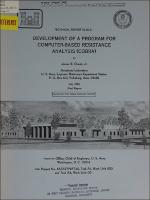Please use this identifier to cite or link to this item:
https://hdl.handle.net/11681/11237Full metadata record
| DC Field | Value | Language |
|---|---|---|
| dc.contributor.author | Cheek, James B. | - |
| dc.date.accessioned | 2016-06-20T14:16:36Z | - |
| dc.date.available | 2016-06-20T14:16:36Z | - |
| dc.date.issued | 1980-07 | - |
| dc.identifier.uri | http://hdl.handle.net/11681/11237 | - |
| dc.description | Technical Report | - |
| dc.description | Abstract: This report describes the development of a computer-based approach to evaluating the hardness of structures subjected to attack by nonnuclear weapons. The program has the following features: (A.) It introduces a normal random change in projectile impact point with respect to aim point. This models the targeting uncertainty of weapon delivery systems. (B.) It accounts for both blast- and fragment-induced damage for each shot. (C.) It models the cumulative damage and the resultant increase in vulnerability produced by a series of shots (an attack). (D.) It considers the redundancy of structural elements and approximately models their structural behavior with respect to blast-induced failure. (E.) It models the curved path (J hook) of projectiles in soil. (F.) It provides for proximity, contact, and delay fusing. (K.) It models the vulnerability of personnel protected by structures and provides for user-specified vulnerability graphs for components protected by structures. The main objective of this program development effort is to provide the designer of protective structures and the military strategist with specifications which relate hardness to the number of shots per attack and the number of attacks. By this means, it is anticipated that more economical (time or money or both) designs can be developed for various combinations of shots per attack, numbers of attacks, and weapon intensity. In like manner, a more real-world-oriented assessment of "enemy" structures will result from assessing hardness in terms of the probability of surviving various numbers of shots from a particular weapon system. | - |
| dc.publisher | Structures Laboratory (U.S.) | - |
| dc.publisher | Engineer Research and Development Center (U.S.) | - |
| dc.relation | http://acwc.sdp.sirsi.net/client/en_US/search/asset/1035866 | - |
| dc.relation.ispartofseries | Technical report (U.S. Army Engineer Waterways Experiment Station) ; SL-80-5. | - |
| dc.rights | Approved for public release; distribution is unlimited. | - |
| dc.source | This Digital Resource was created from scans of the Print Resource | - |
| dc.subject | COBRA | - |
| dc.subject | Computer program | - |
| dc.subject | Protective structures | - |
| dc.subject | Conventional weapons | - |
| dc.subject | Random processes | - |
| dc.subject | Hardened installations | - |
| dc.subject | Structural analysis | - |
| dc.subject | Projectiles | - |
| dc.subject | Weapons effects | - |
| dc.subject | Blast effects | - |
| dc.subject | Explosion effects | - |
| dc.subject | Structural dynamics | - |
| dc.subject | Projectile penetration | - |
| dc.subject | Data processing | - |
| dc.title | Development of a program for computer-based resistance analysis (COBRA) | - |
| dc.type | Report | en_US |
| Appears in Collections: | Technical Report | |
Files in This Item:
| File | Description | Size | Format | |
|---|---|---|---|---|
| TR-SL-80-5.pdf | 14.24 MB | Adobe PDF |  View/Open |